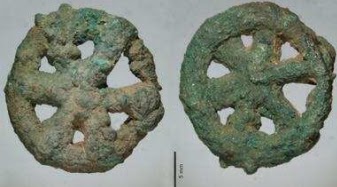http://tinyurl.com/y6jymj68
This monograph is a speculation on the chronology of the early writing systems, based on the orthography of Sign 391 on Indus Script Corpora (which now contains over 8000 inscriptions from 4th m.. BCE.
![]()
This is an addendum to:
![]() Field Symbol 3 (ASI 1977, Mahadevan Concordance)
Field Symbol 3 (ASI 1977, Mahadevan Concordance)
The spoked-wheel sign appears four times on Dholavira Signboard proclamation.
![Image result for dholavira signboard bharatkalyan97]() Speculative reconstruction.of the signboard on a gateway, Dholavira.
Speculative reconstruction.of the signboard on a gateway, Dholavira.
![Image result for dholavira signboard bharatkalyan97]()
The earliest writing sample is dated to ca. 3300 BCE on a potsherd with Indus Script from Harappa by HARP team).. If this date is validated further, this may signify the earliest writing system on the globe.
![]()
This monograph is a speculation on the chronology of the early writing systems, based on the orthography of Sign 391 on Indus Script Corpora (which now contains over 8000 inscriptions from 4th m.. BCE.
This is an addendum to:
One-horned young bull PLUS spoked wheel signifies कोंद kōnda ‘engraver, turner' and akṣaracaṇa 'scribe' working with eraka 'knave of wheel' rebus 'molten cast, metal infusion' https://tinyurl.com/y2ongqg6
Dholavira signboard on अर्क शाल 'goldsmith workshop' and Mehrgarh spoked copper alloy wheel proclaim akṣaracaṇa 'scribe' the metallurgical competence of artisans to engrave on metal https://tinyurl.com/y6fp3zkq
It is possible that the potter's spoked wheel pre-dates the spoked wheel of a cart or chariot. The presence of cire perdue copper alloy spoked wheel shapes of a very early date ca. 4h or 5th m. BCE (called amulets by British Museum and Indus Script hypertexts by me) is also an indicator that the shape was adopted as a hieroglyph/hypertext on Indus Script inscriptions. I am speculating on the chronology of the evolution of early writing systems. See also the spoked wheels on artifact from Bhirrana which dates from 7th m BCE.The spoked-wheel sign appears four times on Dholavira Signboard proclamation.
 Speculative reconstruction.of the signboard on a gateway, Dholavira.
Speculative reconstruction.of the signboard on a gateway, Dholavira.The earliest writing sample is dated to ca. 3300 BCE on a potsherd with Indus Script from Harappa by HARP team).. If this date is validated further, this may signify the earliest writing system on the globe.

Mehergarh, 5th millennium BCE. 2.2 cm dia. 5 mm reference scale. Perhaps coppper alloyed with lead. It is remarkable, that this six-spolked cire perdue copper alloy wheels made in Mehrgarh becomes a hieroglyph of Indus Script on Dholavira signboard.







